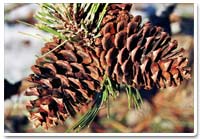Pine Nuts
An Introduction

They’re a key ingredient in Italian pesto, of course. The Koreans make porridge out of pureed pine nuts and beef stock. In the Chinese city of Suzhou, pine nuts embedded in rock candy are a local specialty. Europe, Asia and North America have different species of pine, and most have edible nuts. Chinese nuts tend to be larger and many of them chefs argue that Italian ones have more flavor.
Native Americans of the Southwest eat roasted pine nuts as snacks, and so do those of the Lake Tahoe area. Pine nuts also are eaten as snacks, sort of like sunflower seeds, in much of the Western United States, where they are available roasted and still in their shells right after the autumn harvest at roadside stands and are called pinion nuts.
What are Pine Nuts?

The commercially important nut producing pine are the stone pine of southern Europe; the Swiss stone pine native to the Swiss Alps and eastward through Siberia to Mongolia; and the pinon pine of the arid regions of the southwestern United States.
Pine nut oil extracted from the edible seeds of several species of pine, has a delicate, nutty taste and is used as a flavoring agent. The oil’s rich flavor makes it a good choice for marinades, for use on vegetables, or in salad dressings. Since pine nut oil has a relatively low smoke point, it is therefore not generally used during cooking.
Reference in Literature
Health Benefits of Pine Nuts

- Antioxidant protection
- Appetite suppression
- Dietary fiber
- Cardiovascular health (oleic acid in pine nuts helps to eliminate triglycerides).
Pine nuts are also believed to be an appetite suppressant. This is attributed to a hormone found in the nuts called cholecystokinin (CCK). Pine nuts also contain pinolenic acid, a polyunsaturated fat that encourages two hormones, which help to suppress hunger. This quality makes the protein-packed nuts a perfect addition to trail mix because they help with both energy and satiety.
Pine nut pesto is a popular, rich-tasting sauce, used as a pasta topper–a mouthwatering combo of nuts, cheese, garlic and basil.
Storage
Shelled and unshelled pine nuts can be kept on hand but should be stored in an airtight container. Nuts can be stored in the fridge for approximately one month. For longer storage, pine nuts can be placed in the freezer.
Pesto Spaghetti

Ingredients:
- 1/2 cup minced parsley
- 2 cups fresh minced basil, firmly packed
- 1 tsp. salt
- 1/8 tsp. white pepper
- 4 cloves garlic, minced
- 2 tblsp. butter
- 1/2 cup olive oil
- 3/4 cup Parmesan cheese
- 1 1/2 lb. thin spaghetti
- 1/4 cup minced pine nuts
Directions:
Combine basil, pine nuts, parsley and garlic in processor or blender and puree; add oil and butter gradually in a slow, steady stream until mixture is the consistency of mayonnaise. Add white pepper and salt to taste. Pour sauce over cooked spaghetti in a large shallow serving bowl and toss well. Serve immediately with Parmesan cheese. Finely chopped walnuts substitute for pine nuts. The sauce can be frozen.













